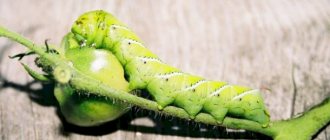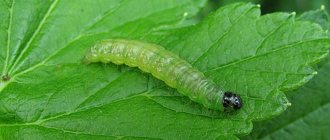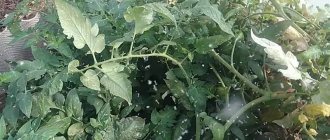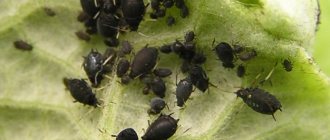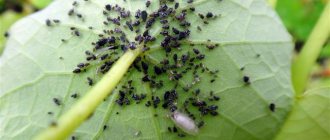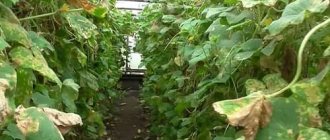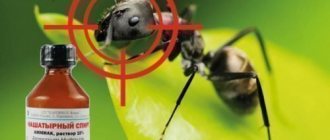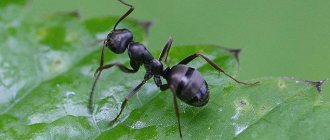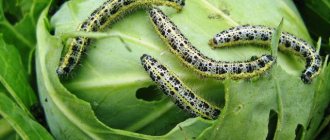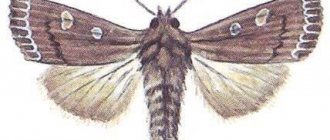30.06.2019
It is impossible to insure against the appearance of harmful insects on carefully grown seedlings. Omnivorous insects attack young shoots, inflorescences, and can destroy the entire crop. What pests can be encountered in a greenhouse when planting peppers and tomatoes, the life cycle of these parasites, as well as a review of effective means of combating them is given below.
- What caterpillars breed in a greenhouse?
- Pest development stages
- Effective treatment methods and control methods
- How to prepare a greenhouse for planting
Caterpillar and moth moth (photo)
Scoop.
Why do they appear
There are not many reasons why pests appear on tomatoes. Butterflies look for favorable places to live in a warm and protected greenhouse, where they remain.
Several reasons for the appearance of caterpillars in a greenhouse:
- Lack of preventive measures when setting up a new greenhouse. Cutworm and whitefly eggs overwinter in the soil. If the greenhouse is installed in an infested area, then with the onset of warm weather, pests can be expected to appear on greenhouse plants.
- They penetrate through vents, windows and doorways. Butterflies can simply fly into the greenhouse and stay there, giving life to new generations.
- Infected new plants. Whitefly larvae can also take root on plants recently purchased at the store. It can be very difficult, and sometimes even impossible, to notice them.
Armyworm caterpillar
The caterpillar is fertile.
- She is capable of laying about 500 eggs during the summer. Places for laying are flowers and leaves. The eggs are flat at the bottom and convex at the top.
- In a warm environment they can ripen within 2–5 days, and in a cool environment – from 4 to 10 days. After completion of development, they settle in the soil.
- The period of pupation and wintering begins. The lifespan of an adult moth is from 20 to 40 days.
- Development takes 20 days. The naked body has a gray, yellow-green, brown color. The pest is quite long and large. Sometimes the length reaches 2 cm.
Insects are not easy to see. Caterpillars and butterflies are active exclusively at night.
Caterpillar on tomato tops.
Cutworms greatly damage greenhouse tomatoes. They eat tops, buds, and tomatoes. They chew holes and live inside. Affected vegetables should not be consumed by people. They also love to eat eggplants, cabbage, and peppers.
The warm and humid greenhouse environment is very favorable for pests. At temperatures below 10 degrees, insects die. However, the eggs are able to survive winter frost in the upper layer of the earth.
Sap sucking isn't the only problem caterpillars cause. They carry infections. Plant oppression occurs. It doesn't grow any further. The fruits should not be eaten.
Pest development stages
All garden crops are susceptible to attacks by leaf beetles. They especially love tomatoes, peppers, eggplants and zucchini. An adult (butterfly) rarely poses a threat, but its offspring, when growing up, are capable of destroying most of the crop. To determine how to get rid of caterpillars as quickly as possible, it is important to find and eliminate the root cause of their appearance.
How garden crops are damaged:
- Directly butterflies, which can penetrate the greenhouse, lay a clutch of eggs on the planted plants.
- Purchase of infected seedlings, on the leaves of which pests have settled.
- Using soil with larvae or eggs inside.
- High humidity and wetlands are ideal conditions for the development of these insects.
Butterflies and caterpillars can enter from neighboring areas and vacant lots. For a good result, it is necessary to combat them comprehensively, teaming up with neighbors and carrying out treatment at the same time.
The appearance of pests in greenhouses
By certain signs you can understand that insects have appeared:
- small and adult individuals can be seen in the lower parts of the leaves;
- the upper part of the leaf is covered with white “powder”, later the leaf turns black;
Cutworms eat tops and fruits.
- the tops dry out and curl;
- tomatoes have inedible whitish pulp;
- tops with “bites”, uneven edges, spots;
- tomatoes with gnawed holes and insects inside.
The armyworm is very visible, and the whitefly can be detected by shaking the plant.
Pests appear in several ways.
- An adult insect flies into a greenhouse and lays eggs.
- Also, pupae and larvae may remain in the soil that was brought into the greenhouse.
In a warm environment they can multiply quickly.
What plants repel cutworms on tomatoes?
Cutworms are insects that are repelled by strong-smelling plants. Therefore, if you saw a lot of similar insects in your garden last season, you can take care of planting plants with a strong odor.
List of plants:
- Chernobryvtsy
- Bird cherry
- Thyme
- Mint
- Sagebrush
- Calendula
- Cornflowers
Please note that it is necessary to plant these plants in certain flowerbeds and groups. It is best to surround beds with tomatoes with similar plants. They will interrupt the smell of tomatoes, which is what cutworms usually focus on. This option is ideal if cutworm butterflies have appeared. But it is practically useless if there are many young larvae that eat the roots. In this case, it is better to use insecticides. There are also ways that can significantly reduce the number of armyworms next year. Therefore, it is worth paying more attention to prevention.
Armyworm repellent plants
Several methods of prevention:
- Dig up the plants in the fall to a depth of 25 cm. Remove all weeds and burn them, as well as torn out tomato tops. All remaining bushes must be burned.
- Be sure to clean up weeds. After you dig up all the tomato bushes after fruiting, you need to burn the tops and dig up the garden to a depth of 25 cm.
- The same manipulation must be done in autumn and spring, during the growth of tomato bushes. It is necessary to constantly clean the garden of weeds. The fact is that cutworms can lay eggs on weeds, so it is necessary to have as few of them as possible.
- Also pay attention to the neighborhood. The best option would be to plant plants nearby that smell very strongly. They will shoot down the scoop.
- If you see that there are holes in the plants, and the tomato fruits are damaged, then in this case it is necessary to use insecticides. All traditional methods will be ineffective, since they fight rather slowly. Adults or large caterpillars are not destroyed in this way. A stronger and more serious impact is needed.
Cutworm Butterfly
As you can see, there are a lot of options for dealing with cutworms. The main thing is not to neglect your garden and devote a lot of time and attention to prevention. The most basic way to prevent cutworm infestation of your tomatoes is to dig deep. After all, cutworm larvae overwinter inside the soil, and if you dig deep into the soil in the fall, almost all of the larvae will freeze out over the winter.
How to deal with caterpillars in a greenhouse
It is imperative to ventilate the greenhouse. This will ensure normal oxygen circulation and no condensation. Pests prefer highly dense plantings. It is necessary to do regular weeding and get rid of old lower branches and unnecessary side shoots.
There are several ways to eliminate pests.
Chemical
Pesticides are very effective in this matter. But they pose a danger to plants and humans. Complete release of pesticides takes from 20 to 30 days. It is advisable to calculate the expected harvest date.
Insecticides are a last resort solution to the problem. Toxic components tend to accumulate. They are able to be absorbed into several generations of plantings. The fastest withdrawal is for drugs with hazard class 4. These are “Aktofit”, “Lepidotsid”, “Fitoverm”, “Agravertin”.
They are treated with a respirator, protective clothing, thick gloves and goggles. At the same time, the doors are opened and processing is carried out very quickly.
The following are considered universal drugs:
People's
Traditional methods are effective at the initial stage of the appearance of insects.
Garlic
Finely chop the head of garlic and pour it into a saucepan (volume 1 liter). Pour boiling water and leave for 3 days. Then add half a glass to a bucket of water. Spray the plant.
Sagebrush
Freshly cut wormwood is poured into a bucket. A third of the container should be occupied. Fill with water. Boil for half an hour. Infuse for 2 days, filter. Leaves and stem are treated.
Tobacco and shag
Shag will also help. Shag (300g) is poured into a bucket of heated water. Insist for 1 day. Spray the plant. Using the same principle, they are sprayed with tobacco infusion.
Laundry soap
Laundry soap shavings are dissolved in water and whipped into a thick foam. Collect bubbles with a sponge and apply to leaves on both sides. This composition remains on the leaves and prevents pests from feeding.
Salt
The saline solution can corrode the caterpillar. To do this, dilute salt in warm water. However, proportions in gardeners’ recipes are most often “by eye”.
Tops
Potato tops are one of the most effective remedies. The green part is added to water in proportions of 1:10. Set aside and filter. Add a little laundry soap and stir.
It is necessary to add laundry soap to any prepared composition. This promotes longer action on the sheets. Usually one third of a bar of soap is rubbed. Then the grated soap is stirred and processed. Spray along the entire length. But special attention is paid to the lower part of the leaves.
Pest catching
Bait trap.
It is also appropriate to use a fumigator and traps. Typically, yellow cardboard is chosen and honey, thick oil, Vaseline, and garden glue are applied. Caterpillars are not interested in such bait. Only butterflies get caught.
You can dig a container with compote or kvass into the ground. The pleasant aroma will attract insects. Burdock tincture is a great option. Burdock is chopped and added to water. Leave for 4 days. Strain and add soap shavings.
Signs of appearance
The appearance of caterpillars on tomato bushes significantly affects their well-being, so it is quite easy to spot pests based on the following signs:
- leaves dry, curl and fall off;
- stems and foliage are damaged and holes appear on them;
- plants look weakened;
- growth slowdown;
- delay in the appearance and ripening of fruits;
- poor fruiting;
- deep black holes in fruits;
- the foliage becomes covered with a black coating;
- when shaking the bush, a swarm of white “midges” rises into the air;
- On the reverse side of the leaves, clutches of eggs and larvae are found.
Did you know? Cutworms have natural enemies in nature. Among these insects are Trichogramma, tahina fly and ichneumon fly.
Preventive methods
Pest control is not that easy. It is better to avoid insects. To do this, preventive maintenance is done annually:
- after the end of the season, be sure to collect all the remains and burn them;
- In the fall, they dig deep into the greenhouse soil. Remove more than 15 cm of soil and replace it with fresh soil;
- disinfect the soil, water it with boiling water or potassium permanganate;
- dig up periodically so that there are no weeds;
- water the seedlings at the roots in the morning so that the moisture evaporates until the evening;
- if there are self-pollinating plants, install mosquito nets or hang a gauze or tulle curtain;
- treated with "Decis", "Citkor" with a break of 7 days.
How to treat and spray tomatoes against green caterpillars that eat them: preparations
You need to fight the cutworm not only after you see eggs or pupae or damaged leaves, but immediately after discovering the clutch. In addition, the most effective is prevention, which will prevent the emergence of new insects and their spread. To combat the armyworm, both folk remedies and chemicals are used. Biological substances that are active against younger caterpillars are very effective.
List of drugs:
- Agravertine
- Decis
- Zeta
- Arrivo
- Inta-Vir
- Sherpa
Basically, all these substances are dissolved in water, after which the seedlings and bushes are sprayed. You can water in the root area. For more details, please see the instructions for the specific drug.
Armyworm caterpillar
Folk methods of getting rid of scoops
If caterpillars eat tomatoes, but there is no money to purchase chemicals, you can use traditional methods of control. Among them are:
Caterpillars on tomatoes in a greenhouse do not like the smell of garlic, so all seedlings must be treated with an infusion with the addition of garlic. To prepare it, take a bunch of garlic arrows and mix with boiling water in a 3-liter container. All this should be insisted for 3 days.
You can use a decoction of wormwood. Approximately half a bucket of water is filled with wormwood and filled with water. The mixture must be boiled for at least 30 minutes, after which it is used to spray tomatoes.
Traditional methods of fighting caterpillars on tomatoes CATERPILLARS IN THE FRUITS OF TOMATOES - HOW WE GOT RID OF THEM
You can add a bar of soap to any of these solutions. In the greenhouse, the caterpillar on the tomatoes is afraid of the smell of this detergent.
You should also water the insects with cold water. The procedure is carried out early in the morning.
Tatyana Orlova (candidate of agricultural sciences):
Folk remedies can be used not when the caterpillars appear, but when the butterflies of these pests fly. Tinctures with pungent odors are used to disorient insects, because They find food sources by smell.
Basic methods of struggle
Used to control tomato cutworm:
- manual collection of caterpillars;
- spraying with chemicals;
- treatment with folk remedies;
- biological method.
Chemicals
How to deal with green caterpillars on tomatoes in a greenhouse? Chemical treatment is the most effective method of pest control. Spraying is carried out taking into account the fact that pesticides are removed from the fruit within 20-30 days. Therefore, before using chemicals, calculate the expected start date of harvest.
Attention! Gloves are used to protect the skin, and respirators are used to protect the respiratory system.
List of effective means:
- "Inta-Vir" is a contact-intestinal insecticide. The substance cypermethrin destroys butterflies and caterpillars. The protective effect lasts up to 15 days. Dissolve 1 tablet in 10 liters of water and use it during the tomato growing season.
- "Decis Profi" is a fast-acting contact-intestinal insecticide. Belongs to the class of pesticides moderately hazardous to humans. Contains the substance deltamethrin. To treat 100 m², 0.5 g of the substance is dissolved in 5 liters of water. The product is used before flowering. The protection period is 10-15 days.
- "Avant" is an insecticide of moderate hazard class for humans. Contains the substance indoxacarb. Resistant to rain, effectively destroys eggs and caterpillars. The consumption rate per 1 ha is 200-300 ml. The product is used no more than twice during the growing season.
- "Arrivo" is a contact-intestinal insecticide. Shows high effectiveness against cutworm caterpillars at low application rates. Consumption per 1 ha – 240-320 ml. Treatment is one-time, during the growing season.
- "Aktara" is a systemic insecticide with contact-intestinal action. The active ingredient is thiamethoxam. Destroys the caterpillar at the feeding stage. 4 g of powder for irrigation or 1.2 g for spraying are dissolved in 10 liters of water.
- "Tanrek" is a systemic insecticide with contact-intestinal action. The active ingredient is imidacloprid. The protection period is 30 days. The drug can be combined with Fitosporin. The product is used for spraying (5 ml per 10 liters of water).
- "Fitoverm" is an enteric contact insectoacaricide. Irrigation is carried out twice during the entire growing season. 1 ml of the drug is dissolved in 10 liters of water. The protection period in the greenhouse is up to 20 days, in the garden – up to 15 days.
Important! It is recommended to alternate chemicals used to kill cutworm caterpillars from season to season. The pest is highly resistant to such agents. What worked this year will not work next year.
TOMATO MOTH and COTTON BULLSHIT ON TOMATOES IN GREENHOUSES (03-08-2018)
Folk remedies
Folk remedies are effective in detecting the first pests . Unfortunately, in case of mass destruction, they do not bring results.
Recipes for folk remedies:
- Pour a bunch of chopped garlic arrows or a head of garlic into 1 liter of hot water and leave for 3-4 days. Bring the product to a volume of 10 liters and use it to treat bushes twice a month.
- Pour 300 g of tobacco dust into 10 liters of boiling water and leave for 24 hours. Apply to spray tomatoes every two weeks.
- Fill a galvanized barrel with chopped bird cherry herbs and fill it to the top with boiling water. Leave for a day, use for spraying bushes and watering the soil.
- Pour a kilogram of fresh wormwood into 3 liters of water and boil for half an hour, then increase the volume to 10 liters and irrigate the bushes twice with an interval of two weeks.
- Fill a 10-liter bucket with burdock, chamomile, datura, yarrow, celandine, potato tops (optional) and fill with water. Leave for four days and use to irrigate bushes once every two weeks.
Mix shavings of laundry or tar soap into each solution. For a 10 liter bucket – 30-50 g.
A saline solution is effective against cutworms . Dissolve 2 tbsp in 10 liters of water. l. rock salt and water the bushes generously.
Prevention
Before the onset of winter, the caterpillars go into the soil, pupate and mummify until spring. Whiteflies and cutworms overwinter at a depth of 10 to 25 cm, to protect tomatoes from their invasion next season, you need to:
- In the fall, dig up the beds freed from tomato bushes to a depth of at least 30 cm (the bayonet of a shovel), turning over and without breaking the clods of earth. Pupated caterpillars that are on top will die from the cold in winter.
- In early spring, water the soil for tomatoes with hot water with the addition of soda or potassium permanganate. Pupae of pests, if they are preserved, will die under the influence of heat treatment.
- Before planting tomato seedlings in a greenhouse, you can sow white mustard seeds in the beds (2 months before). Immediately before planting tomatoes, dig up the beds along with mustard seedlings, and then spray the seedlings with a weak solution of dry powder.
Preserving the harvest and not letting it be eaten by insatiable caterpillars is the primary task of gardeners. Preventive measures using folk remedies are effective in such cases and do not harm either humans or the environment.
Various pest control methods
Chemical active substances are rightly called the most effective way to destroy caterpillars. Their disadvantages include an increased risk of introducing a significant amount of toxic substances into the future harvest, so treatment is carried out in 2 cases - before the flowers begin to set or in the event of a massive pest invasion.
Before spraying tomatoes with special preparations, you need to look at the calendar. Chemicals are removed from seedlings within 30 days, so there is no need to process the crop on the eve of harvest.
When choosing insecticides, preference is given to those substances that equally affect caterpillars and butterflies, otherwise the treatment will not be effective enough.
Drugs
| A drug | Mechanism of action |
| "Inta-Vir" | For every 10 liters of water take 1 tablet. Spraying is carried out 2 times per season. |
| "Decis" | For every 5 liters of water, take 100 g of emulsion concentrate. Provides protection for tomatoes for only 15 days, after which re-treatment is carried out. |
| "Avant" | The solution is applied to the surface to be treated only in dry and hot weather. It is used once per season, otherwise the tomatoes will have an increased level of concentration of chemicals. |
| A drug | Mechanism of action |
| "Aktofit" | Add water and 1/3 of the required volume of the drug to a 5-liter bucket. As soon as the solution has become homogeneous, add the remaining volume of water. Recommended concentration is 5 ml of solution for every 1 liter of water. Carry out 2 treatments during the season. |
| "Fitoverm" | For every 10 liters of water take 1 ampoule. Treatment is carried out 2 times per season. |
| "Lepidocil" | For every 10 liters of water take 20 ml of the drug. The treatment is carried out before the flowers begin to set. |
Every year it is recommended to use various chemicals and biologically active substances, otherwise the pest will develop a strong immunity.
Folk methods of struggle
You need to resort to them, the sooner the better. In cases where there is massive damage to tomato plantings, popular recommendations are useless. The first recipe looks like this:
- 2 heads of garlic;
- 2 bunches of medium-sized garlic arrows;
- 1 jar, the capacity of which is 1 liter;
- put the ingredients in a container and add water;
- Infuse for 72 hours;
- strain;
- Add ½ cup to 1 bucket of water;
- add ½ bar of laundry soap, which has been previously crushed.
Treatment is carried out 2 times per season. The second folk method of fighting caterpillars includes the following ingredients:
- 1 bucket;
- fill it 1/3 with fresh wormwood;
- fill with cold water;
- bring to a boil over low heat for 30 minutes;
- Infuse for 48 hours;
- strain;
- dilute with fresh water in a ratio of 1:10
- add ½ bar of laundry soap, which has been previously crushed.
The list of folk recipes ends with a mixture of boiling water and tobacco dust. To prepare the mixture, 300 g of product and 2 liters of hot water are required. The solution is infused with the lid closed for 24 hours.
The next step is to add ½ part of a crushed bar of laundry soap. The mixture is brought to a homogeneous state. Treatment is carried out 2 times per season.
In the case where we are talking about the average degree of pest damage to plantings, the following recommendations will come to the rescue:
| Substance | Description of action |
| Cold water | This technique is used only in the early morning, until the surface of the leaf is heated by the sun. Otherwise, the gardener’s actions will provoke a shock. Water is supplied under low pressure. With its help, you can wash off larvae and caterpillars from the surface of the leaf and stem. |
| Lather | If we are talking about a small greenhouse, then green or laundry soap will come to the rescue. It is enough to beat it into a stable foam, which is then carefully applied to the outside and inside of the sheet. |
| Water-salt solution | 1 package of table salt is diluted in 10 liters of water. Spraying is carried out once every 5 weeks. When exposed to salt, the caterpillars die. The disadvantages of the described technique include 2 factors. First, if the specified dosage is exceeded, the risk of fruit damage increases. Second, salt has virtually no effect on butterflies. |
| Garlic arrows | Take 1 kg of dry product and pour 2.5 liters of boiling water over it. The mixture is infused with the lid closed for 14 days. As soon as the solution has fermented, it is filtered. The resulting liquid is diluted with cold water in a ratio of 1:10. Total spraying is allowed only in dry weather. |
| Potato tops | To prepare the tincture, you need 1.5 kg of tops, which are filled with water in a ratio of 1:10. Over the next 24 hours, the mixture is infused and filtered. Add ½ bar of laundry soap to the resulting solution. Spraying is carried out every 5 weeks only in warm and dry weather. At high humidity levels, potato tops lose effectiveness. |
How to stop the voracious potato cutworm?
The potato bollworm is a small, inconspicuous butterfly of a brownish color. It seems that such an inconspicuous creature is incapable of causing any particular harm. However, in reality it causes a lot of trouble for many gardeners. It is quite possible to get rid of this pest, but in order for the measures taken to provide the expected result, it is first necessary to find out the characteristics of the parasite’s life.
Useful tips
In addition to the use of various means that are used to treat tomato bushes when infested by caterpillars, mechanical action must also be included in the arsenal of the fight (only in this case the effect will be as effective as possible).
The recommendations are:
- Since both cutworms and whiteflies overwinter in the top layer of soil, it is necessary to dig it up in the fall after harvesting and in the spring before planting.
- If the contamination of the greenhouse was significant, then in the fall it will be necessary to completely remove the entire top layer of soil (about 15 cm).
- Before planting, the soil can be calcined with boiling water or disinfected with a solution of potassium permanganate, which not only destroys pests, but is also a fertilizer.
- If caterpillars are found on leaves, additionally remove them manually. Turn over the leaves and collect caterpillars and eggs.
- Carry out treatment measures at the first appearance of pests. Do not allow caterpillars to grow up, as they become increasingly difficult to kill as they age.
- Throughout the growing season (from planting tomatoes to harvesting), loosen the soil regularly. This will allow you to destroy butterfly eggs in a timely manner.
- Weed the soil in the greenhouse and destroy weeds, which act as additional food for butterflies and caterpillars. If insects are killed on tomatoes, they can remain on the weeds and from there spread again to garden crops.
- In winter, soil that has been infested with parasites can be filled with cold water. The soil will freeze well, which will significantly reduce the number of pupae and eggs in it.
- Whiteflies are well attracted to regular sticky fly strips (especially if they are yellow). Hang these over diseased plants and by evening you will see how many butterflies will be trapped.
Prevention and treatment of tomatoes
It is known that preventing the appearance of caterpillars is less expensive than subsequent painstaking work to correct the situation. For this reason, gardeners are advised to think about a strategy for growing tomatoes in advance.
We invite you to read everything about caring for zamioculcas or dollar tree
The first thing to do is dig up the soil. In the fall, the soil is dug up using a spade, leaving large clods. In the spring, recultivation is carried out, but with subsequent loosening.
Important! If previously the soil contamination with pupae has reached a critical level, the top layer of turf is removed by 15 cm, replacing the soil with clean soil.
The second step to effectively get rid of insects is to water the future beds in the fall with a weak solution of potassium permanganate with boiling water. Moreover, repeating this procedure is appropriate during the spring preparation of the garden.
The third method that can help beginners in the battle with the “enemy” is constant weeding of the beds. Weeds attract cutworms and whiteflies, so thoroughly clearing the soil of the roots of harmful plants and loosening the rows contributes to the victory of the summer resident.
Another nuance is thinning the seedlings. Dense beds favor the proliferation of crop eaters due to the difficulty in processing planted crops.
It is recommended to water the plants no later than 5 pm, so that excess moisture from the soil has time to evaporate before dusk.
One last thing: do not allow caterpillars to hatch from the clutch. Large individuals should be removed from the plant manually - even a “harsh” chemical effect will not have the required effect.
